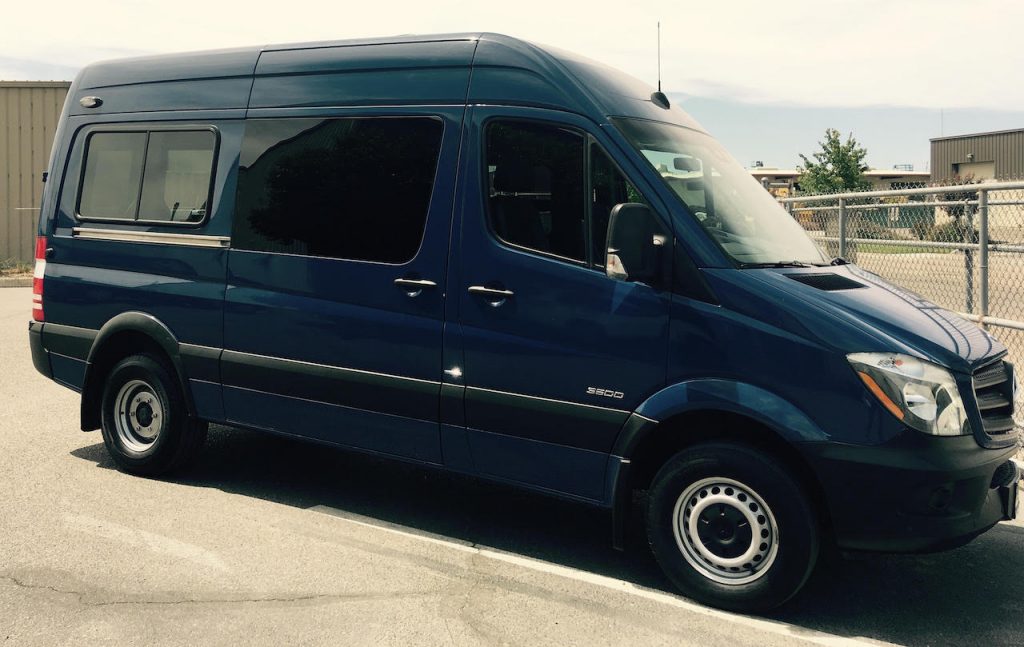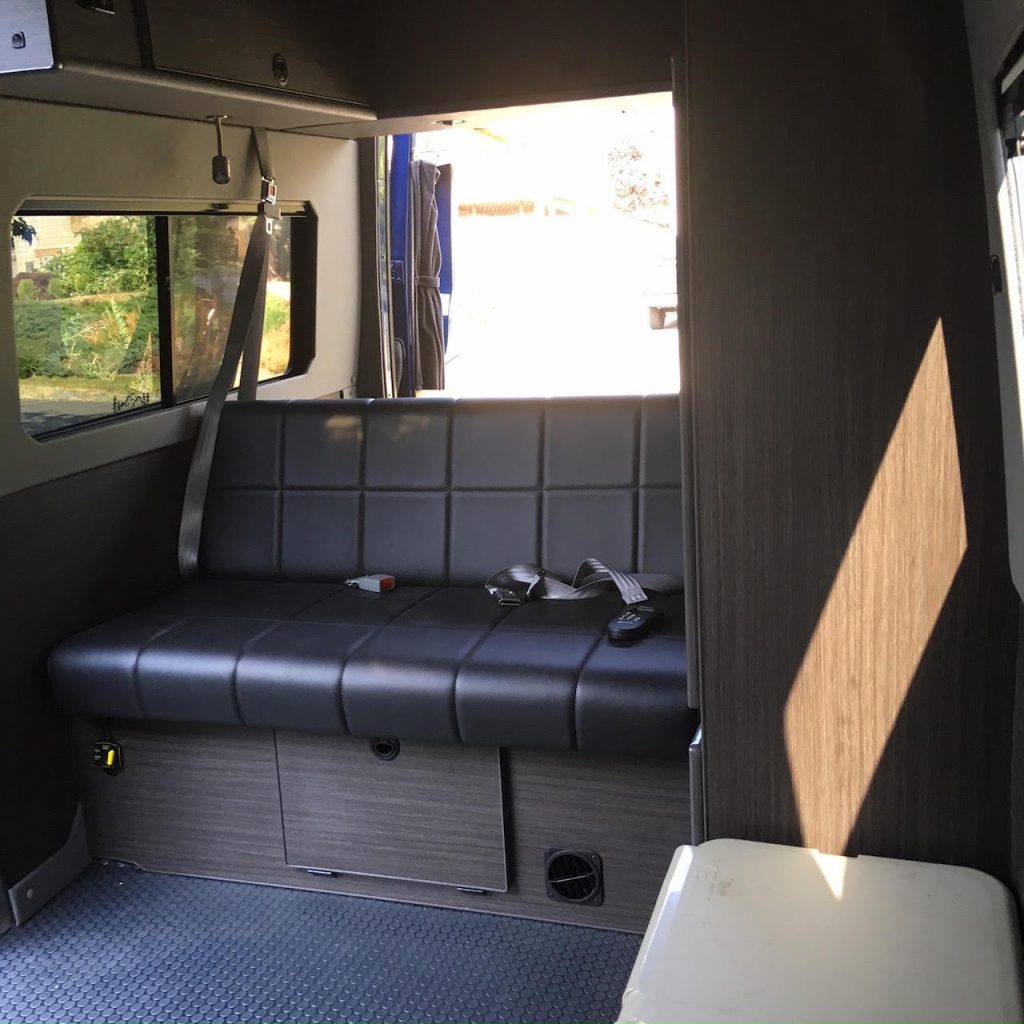We love our current van, Dimes. However, we didn’t purchase him to be a tow vehicle. When we bought the van we were envisioning weekend to week-long trips. The van is perfect for that. Now, however, we’re focussed on longer-term travel towing our Airstream, Wobbles. For that purpose, Dimes could be improved upon.
Payload capacity and towing capability
Dimes is a 2000 Ford E-150 van with a 4.6L V8 gas engine. I wrote about Dime’s payload issues extensively in the post “Weighing in at 11,420 lbs“, but Dimes is a light-duty van. He’s not made to carry a lot of weight. He’s rated to hold 7,000 lbs. Mostly empty, I weighed the van at 6,400 lbs. That only leaves 600 lbs for passengers, gear, AND the trailer tongue weight. We likely went a few pounds over that limit on this last trip.
Further, although Dimes does have a V8 engine, it’s on the smaller size as far as displacement and only has a 4-speed transmission. Towing 4500 lbs Dimes did pretty good on flat terrain. But as soon as things got hilly, Dimes really struggled to maintain speeds faster than 25-40 mph. Further, our already-not-great towing gas mileage of 10 mpg went down to 9 or 8 on steep hills.
Now the Sprinter is no monster truck by any means. It has a much smaller engine, in fact, than the Econoline’s 4.6L V8. The Sprinter we’re looking at has a 4-cylinder turbo diesel. That’s half as many cylinders!
Looking at side by side specs:
| 2000 Ford E-150 | 2015 Sprinter 3500 | |
| Engine | 4.6L V8 Gasoline | 2.1L I4 Turbo Diesel |
| HP | 215 HP @ 4450 RPM | 161 HP @ 3800 RPM |
| Torque | 290 Ft-Lb @ 3250 RPM | 265 Ft-Lb @ 1400 RPM |
| GVWR *1 | 7,000 lbs | 9,900 lbs |
| GCWR *2 | 11,500 lbs | 15,250 lbs |
| Towing Capacity | 6,600 lbs | 7,500 lbs |
| Payload Capacity *3 | 1,400 lbs | 4,457 lbs |
| Transmission | 4-speed automatic | 7-speed automatic |
*1 GVWR (Gross Vehicle Weight Rating): The maximum combined weight of the vehicle and all the cargo.
*2 GCWR (Gross Combined Weight Rating): The maximum combined weight of the vehicle, all the cargo, and any trailer being towed.
*3 Payload: The GVWR minus the weight of the vehicle itself– i.e, what’s left over for your bodies and stuff. This doesn’t account for the weight of the camper conversion.
The sprinter is actually weaker in both the horsepower and torque departments. However, it has 2 things going for it: low-end torque and a 7-speed transmission.
While the Sprinter has slightly less maximum torque compared to the E-150, it has it at 1400 RPM compared to 3250 RPM on the Ford. With the Ford, we found that on steep inclines we could do OK if we could get a ‘running start’ and get the RPMs up before we got to the steep sections, but if we slowed for any reason (like if we got stuck behind a semi), then we were done for and had to finish the climb at 25 mph in first gear.
My hope is that with the low-end torque of the Sprinter diesel we’ll be able to consistently crawl up hills at a moderate speed, rather than having to play the RPM game.
As far as gears go, we found with only 4 gears we were constantly bouncing between 2 gears on inclines. Second gear would get the van up to speed, it would shift to 3rd, struggle to maintain velocity, and then drop back down to 2nd, over and over. Three extra gears will hopefully be a big improvement in that area.
On the Sprinter forums folks claim that the van tows trailers similar to ours really well. Fingers crossed that they’re right!
When it comes to payload, there’s no comparison– the heavy duty Sprinter can hold over 3 times as much weight as the light duty Ford. We won’t have to count every pound like we did in poor old Dimes.
Storage
Dimes has a pop-top roof tent. This is awesome for having space to sleep 4 people in a van that still fits in parking garages. However, that tent space above the ceiling obviously isn’t useful for storage when we’re driving and the pop-top is closed. As such, the storage in Dimes is somewhat limited.
This wouldn’t be an issue if we had a larger trailer, but our Airstream also does not have much storage (at-least for 4 people living full time out of it) or weight capacity (being a single axle trailer). Therefore, we rely on the van for extra storage for food, clothing, sporting goods, extra water, etc.
We usually had extra stuff filling up the floor space in Dimes, such as jugs of water, firewood, and a basket of snack food for the drive. Because many of the cabinets are low to the ground, this stuff on the floor also made it hard to get into the cabinets. Our youngests’ car seat also blocked another cabinet.
This might all sound like trivial stuff, but we really found that our #1 frustration on the road was not having the stuff we needed easily accessible. Having to dig and empty out an entire cabinet to find the thing you need on the bottom gets less fun the more often you do it! :). These things aren’t a big deal at all for weekend trips or week-long trips, but it feels different when it’s “full time”.
Being able to stand up
Since our Airstream is quite small for 4 people, it really serves only as a bedroom, kitchen and bathroom. There is no living space left over, and there isn’t a table (unless we convert the girls’ bed each day, which we found we didn’t care to do). Therefore, the van serves as our “living room”.
In Dimes we can stand up in a section of the van when the pop-top is up. If we were in warm weather all the time, we probably would have popped the top of Dimes more. But more often than not, we found the temperatures weren’t high enough that we wanted to turn our roof into a tent.
Therefore, we spent a lot of time crouching in our living room. Again, if we were just doing a trip for a few weeks this would not be a big deal at all, but after multiple months we found ourselves really wishing we could just stand up!
The new van

Ok, it’s not completely ours yet.. but we’ve put a down-payment on it and we should have it in a few weeks.
The van is a 2015 Sprinter 3500 that we’re purchasing from a gentleman through Craigslist. He bought the van used and then had Sportsmobile convert it into a camper van.
There are a lot of Sprinter camper vans on Craigslist. However, there are almost none that are capable of seating and seat-belting more than 2 people. Most van conversions are made for 1 person or a couple. Many try to cram all the conveniences of a full-size RV into the van (fridge, sink, stove, sometimes microwave, toilet and shower). These appliances can take up a large percentage of the available space in the van.
For us, we need to be able to safely seat at-least 4 people. We also already have a kitchen and bathroom in tow, so we don’t need most of those things in the van.
What we do need is:
- Heat: we hang out in the van at night when the kids are asleep, and in the desert southwest at night in the winter it’s cold.
- Fridge: the fridge in our Airstream is tiny. If we only used that fridge, we would be needing to go grocery shopping every couple of days. Therefore, we relied on the fridge in Dimes for extra space.
- Storage: storage for things that don’t fit in the Airstream or that we want easily accessible when we’re out and about .. warm clothes, rain gear, biking stuff, food, first aid and emergency gear, etc.
- Power: we don’t have enough roof space on the Airstream to fit all the solar panels we want, so we need a van with plenty of space on the roof for panels (no air conditions, etc. taking up room)
Fortunately, the owner of the van we intend to buy had similar requirements when he had the van built out. It’s pretty much all storage. There’s no kitchen (or water tanks), no bathroom, but there are lots and lots of cabinets. There’s also a great Espar diesel heater.

Just like Dimes, the rear bench seat seats 3 passengers and can fold down into a bed.
We’ll add a fridge, solar panels, a front-hitch for our bikes, and probably do the lithium battery upgrade again. But otherwise it’s perfect!
What we’ll miss
There are few things we’ll miss about Dimes when we get the new van.
- Fitting in parking garages: We didn’t need to park in parking garages super often, but when we visited cities in particular it came in handy being able to fit under 7′ ceilings. The Sprinter is nearly 10′ tall so there’s no chance it will make it into parking garages.
- Being able to get the van serviced anywhere: I definitely feel more comfortable with the idea of owning a Ford than a Mercedes. I can bring the Ford into just about any mechanic if I run into problems or need periodic maintenance. With the Sprinter, I’ll need to find a Mercedes dealer or a Sprinter specialist. Depending on where we are, that could mean a 500 mile drive. I will definitely be getting towing insurance! Service is also way more expensive with the Sprinter. I’ve been told a simple oil change runs upwards of $200 (where we paid about $35 with the Ford).
- Being able to use it as a full camper: We do still came in just Dimes without the Airstream a few times a year. When we do, having two beds, a stove and sink comes in handy. With the Sprinter, we’ll put some camp pads on the floor for the girls. We’ll go back to the simpler days of cooking outside on a Coleman and washing dishes with water from a Nalgene bottle :). Nothing wrong with that, it will just be a change.
Anyone looking for an awesome GTRV Camper van? We’ve got one for sale!
Craigslist: 2000 Ford E-150 Camper Van + many upgrades




Hi, Justin!
I read your trip’s journal over the weekend! What an adventure your family had!
The new van sounds great. My neighbor has a Sprinter and loves it!
I’m still interested in taking a look at your camper…..will be back in CA by April 2nd. New Michelins on my Mazda, clean oil in the engine. And it’s not raining. Works for me.
Hope to meet you in April!
Natalie
Thanks for the note Natalie. I hope you do get a chance to see the GTRV in April!